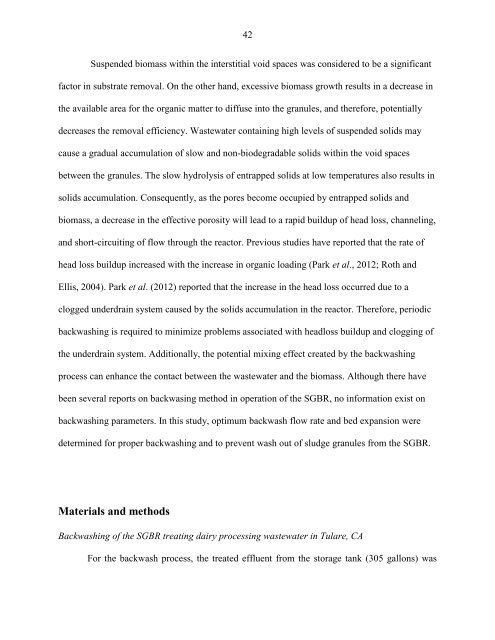THESIS(Jin Hwan Oh).pdf
THESIS(Jin Hwan Oh).pdf
THESIS(Jin Hwan Oh).pdf
Create successful ePaper yourself
Turn your PDF publications into a flip-book with our unique Google optimized e-Paper software.
42<br />
Suspended biomass within the interstitial void spaces was considered to be a significant<br />
factor in substrate removal. On the other hand, excessive biomass growth results in a decrease in<br />
the available area for the organic matter to diffuse into the granules, and therefore, potentially<br />
decreases the removal efficiency. Wastewater containing high levels of suspended solids may<br />
cause a gradual accumulation of slow and non-biodegradable solids within the void spaces<br />
between the granules. The slow hydrolysis of entrapped solids at low temperatures also results in<br />
solids accumulation. Consequently, as the pores become occupied by entrapped solids and<br />
biomass, a decrease in the effective porosity will lead to a rapid buildup of head loss, channeling,<br />
and short-circuiting of flow through the reactor. Previous studies have reported that the rate of<br />
head loss buildup increased with the increase in organic loading (Park et al., 2012; Roth and<br />
Ellis, 2004). Park et al. (2012) reported that the increase in the head loss occurred due to a<br />
clogged underdrain system caused by the solids accumulation in the reactor. Therefore, periodic<br />
backwashing is required to minimize problems associated with headloss buildup and clogging of<br />
the underdrain system. Additionally, the potential mixing effect created by the backwashing<br />
process can enhance the contact between the wastewater and the biomass. Although there have<br />
been several reports on backwasing method in operation of the SGBR, no information exist on<br />
backwashing parameters. In this study, optimum backwash flow rate and bed expansion were<br />
determined for proper backwashing and to prevent wash out of sludge granules from the SGBR.<br />
Materials and methods<br />
Backwashing of the SGBR treating dairy processing wastewater in Tulare, CA<br />
For the backwash process, the treated effluent from the storage tank (305 gallons) was

















